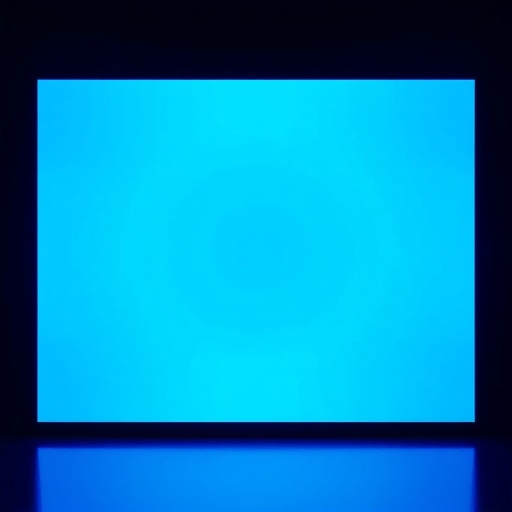In a groundbreaking advance that promises to revolutionize the future of display technologies, researchers at the University of Michigan have succeeded in creating blue phosphorescent organic light-emitting diodes (PHOLEDs) with longevity matching that of the more durable green PHOLEDs currently used in commercial devices. This achievement overcomes a critical bottleneck that has hindered the widespread adoption of deep blue PHOLEDs, which are essential for maximizing the energy efficiency and color performance of OLED screens that dominate premium smartphones and televisions today.
Blue OLEDs have historically lagged behind their red and green counterparts in efficiency and lifespan due to intrinsic material challenges. While green and red OLEDs benefit from phosphorescent emitters that theoretically convert every electron into a photon, blue OLEDs have conventionally relied on fluorescent materials that yield significantly lower efficiencies. This discrepancy arises because blue photons, carrying more energy, stress the organic molecules more intensely. The parasitic trapping of this energy within the device leads to molecular degradation, thus shortening device lifespan, which has posed a persistent challenge for over two decades.
The University of Michigan team, led by Stephen Forrest, has approached this problem by harnessing quantum mechanical phenomena to expedite the conversion of excited states—excitons—into blue photons before they can interact destructively. Central to their approach is the strategic engineering of the device’s architecture to create what they term an “excitonic fast lane,” a concept that leverages the coupling between excitons and surface plasmons—collective electron oscillations on the metallic electrodes. This coupling forms a hybrid quasiparticle called a plasmon-exciton polariton, which promotes swift and efficient photon emission through the Purcell effect.
In a conventional OLED, when an electrical current injects electrons and holes, they form excitons that must decay radiatively to emit light. However, for blue phosphorescent materials, this decay can be sluggish due to quantum mechanical selection rules, increasing the likelihood of exciton annihilation and molecular breakdown. The new design incorporates a thin carbon-based semiconductor layer on the negative electrode, which enhances the interaction between excitons and surface plasmons, thereby accelerating the emission process and reducing harmful exciton collisions.
This enhancement is achieved by positioning the excitons close enough to the electrode surface where the electromagnetic field associated with plasmons is strongest. The carbon layer not only facilitates this coupling but also extends the Purcell effect deeper into the emissive material, ensuring that even excitons further from the electrode benefit. This clever incorporation effectively turns the electrode surface into a mirror that doubles as a quantum accelerator for light emission.
Beyond the plasmonic enhancement, the researchers implemented a tandem OLED structure comprising two stacked light-emitting layers. This tandem arrangement shares the electroluminescent load, halving the exciton density per layer, thereby further mitigating the probability of exciton-exciton annihilation that typically dismantles molecular integrity over time. The entire device acts as an optical cavity with reflective electrodes, which fine-tunes the emission spectrum, pushing the output distinctly into the deep blue wavelength region.
Such advances are pivotal as display manufacturers seek to balance color purity, brightness, energy consumption, and device lifespan. Blue pixels have traditionally been the Achilles’ heel of OLED screens, limiting overall performance and contributing disproportionately to screen aging. By overcoming these limitations, the University of Michigan’s team has unlocked a path towards displays that consume less power while delivering superior color fidelity and durability.
The team’s work, supported by the Department of Energy and Universal Display Corporation, was painstakingly executed using state-of-the-art facilities including the Lurie Nanofabrication Facility and the Michigan Center for Materials Characterization. These institutions provided the precision fabrication and diagnostic tools essential for probing and optimizing the complex interplay of electronic and photonic processes within the OLED stacks.
This research builds on prior studies where the group first demonstrated the concept of activating the Purcell effect through electrode coatings to encourage exciton-plasmon coupling. Now, by integrating multiple complementary techniques and refining the device architecture, they have effectively cracked the long-standing puzzle of blue PHOLED stability, a feat sought by the scientific and industrial communities alike for more than twenty years.
Beyond its scientific merit, this innovation has already moved towards commercialization. The University of Michigan team has secured patents and licensed the technology to Universal Display Corporation, a leader in OLED materials and technology. The collaboration ensures that this breakthrough can be translated into next-generation displays, potentially influencing millions of consumer devices worldwide.
In essence, this breakthrough encapsulates a sophisticated marriage of quantum optics, materials science, and electrical engineering. By finely manipulating the quantum interactions at the nanoscale within OLED devices, the University of Michigan team has pushed the frontier of display technology forward, heralding a new era of energy-efficient, vibrant, and durable screens that could redefine visual experiences across electronic media.
—
Subject of Research: Not applicable
Article Title: Stable, deep blue phosphorescent tandem organic LED enabled by the double-sided polariton-enhanced Purcell effect
News Publication Date: 23-May-2025
Web References:
https://www.nature.com/articles/s41566-025-01679-0
References:
Forrest, S. R., Zhao, H., et al. “Stable, deep blue phosphorescent tandem organic LED enabled by the double-sided polariton-enhanced Purcell effect.” Nature Photonics (2025). DOI: 10.1038/s41566-025-01679-0
—
Keywords
Applied sciences and engineering; Engineering; Electrical engineering; Applied physics; Applied optics; Optical devices; Electronics
Tags: advancements in display technologiesblue PHOLED lifespan improvementboosting blue OLED efficiencycommercial applications of blue PHOLEDslongevity of deep blue PHOLEDsmaximizing color performance in displaysOLED screen energy efficiencyorganic light-emitting diodes researchovercoming blue OLED challengesphosphorescent vs fluorescent OLEDsquantum mechanics in OLEDsUniversity of Michigan OLED research





